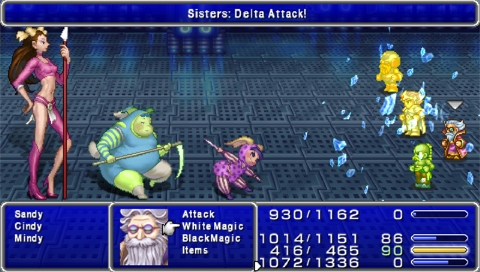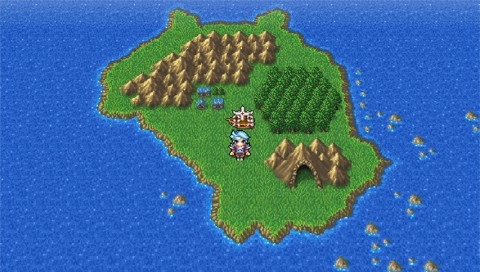
Final Fantasy IV is probably going for a spot in the Guinness Book of World Records for most ports and iterations. After debuting on the Super Nintendo, it’s been ported to the PlayStation, updated for the Game Boy Advance, remade for the Nintendo DS, and now bundled with Final Fantasy IV: The After Years alongside a new Interlude to form Final Fantasy IV: The Complete Collection. A tour de force in nostalgia as well as a series of fun episodes, The Complete Collection is a great item for collectors and FF fans, but not necessarily a “must-have” PSP title.
Platforms: PSP
Publisher: Square Enix
Developer: Square Enix
Genre: Industry-Defining Melodrama
Release Date: April 19, 2011
ESRB Rating: Everyone
Final Fantasy IV
In case you’ve been living under a rock, or are just new to video games, Final Fantasy IV is one of the most revered titles in gaming. It frequently pops up on lists of the most influential RPGs and games in general as the first title to trade quiet heroes for a cast of fully developed characters. This is part a cultural misconception: because Final Fantasy II was skipped over for translation, American gamers never got to know that game’s cast of war orphans. They subsequently mistook the “first game they played” with a realized cast as the first game ever to have one. FFIV nonetheless took storytelling to a new height in gaming, with multiple character arcs within the plot instead of just one overarching tale. The characters’ classes were just one part of their persona, instead of the archetype that consumed them. The setting itself took interactive media to a new level, as the heroes are constantly being taken to new areas you wouldn’t expect to see in a fantasy RPG and to disclose what they are would massively take away from the surprises.
The gameplay side of things saw another innovation with the advent of ATB, or Active Time Battle. Taking the combat away from turn-based and into real-time helped differentiate Japanese RPGs from their original roots in Dungeons & Dragons and its computer RPG progeny like Ultima and Wizardry. In many ways, it was the birth of the JRPG, marrying edge-of-your-seat battles with flashy storylines, using both at the same time to deliver those memorable set pieces that modern developers seem so obsessed with creating.

As influential as it was, the game was not without its faults, and it is starting to show its age. One big factor to FFIV’s success is that the battles were no longer independent of the story; instead, the battles were subjected to it and used as plot devices themselves. This leads to certain aspects of the gameplay being unbalanced, a kind of “spam your cheap and overpowered moves before they spam their cheap and overpowered moves,” philosophy I’ve mentioned before. Towards the end of FFIV, you’re earning such a disproportionate amount of money from enemies that you really don’t need healing anymore. You can just get through each battle using your melee attackers’ ridiculously augmented attacks, then replenish your party’s HP using the hundreds of Hi Potions you’ve accumulated from your seemingly infinite war purse. Endgame peculiarities aside, FFIV is still a title all gaming enthusiasts should play at least once; by all standards, is still a solid play.
Final Fantasy IV: Interlude
We once reported that the PlayStation Blog claimed Final Fantasy IV: Interlude would add in a good fifteen hours of content. I have a personal interest in discerning what Sid Shuman was smoking the day he wrote that, because the game is as its title suggests: an interlude. I managed to wrap it up in about two hours and forty minutes, including checking out the hidden developer’s room that’s a throwback to the original. Perhaps there are sidequests out there to dig up or they meant you could play it for fifteen hours before losing your mind; in any case, it’s fairly short. The game doesn’t do much; it just adds a few quick scenarios revisiting certain areas from FFIV. It begins with a party to celebrate the restoration of Edward’s Damcyan castle, and as a couple mysteries pop up, you go to investigate with a few old friends. While this is essentially a quick rehash of old dungeons with the same characters and system, you do get to see some cool scenarios using party configurations you never got to use in FFIV. This isn’t something every aFFicianado needs to experience, but it’s absolutely a fun little episode.
Final Fantasy IV: The After Years
Final Fantasy IV: The After Years is the part of this collection most people will be playing for the first time and was actually the reason that it was made: to put this story out there in a retail package. Originally a WiiWare title, The After Years was one of those rare episodic series that actually ran to completion, bringing a string of original scenarios featuring new and familiar faces set about 20 years after the last game left off. I have to confess, like many Square fans, I wrote this one off as the company milking every drop they could get out of the udders of the captive FF audience and our beloved franchise. I was wrong.

The After Years distinguishes itself from other Square Enix nostalgia-fests, such as Dissidia, which ignore the resolutions to the stories and instead just give us more of what the meat of the game offered. The After Years instead gives us a new game system within the contours of the 2D FF, and does a good job excavating the original story arcs in a respectful way to build a compelling new narrative. The game begins with Ceodore, the son of Cecil, who is completing his initiation into his father’s old military order, The Red Wings. After a new threat descends on the planet, you begin revisiting the old protagonists who bring along new characters as each one gets a glimpse of the new conflict. Palom is training a mage apprentice in Troia, Yang sets off on an investigation with his daughter, and Edge sends his Ninjitsu practitioners across the globe as sleeper cells trying to figure out what exactly is going on. You get the same novelty as FFIV: Interlude, playing new party configurations in old scenarios and settings, but there’s just enough new locales and variation on the old ones to really stand on its own. The character interaction is excellent and the dialog is actually very well written. If may be a marketing cliche, but if you liked FFIV, you’ll love The After Years.







